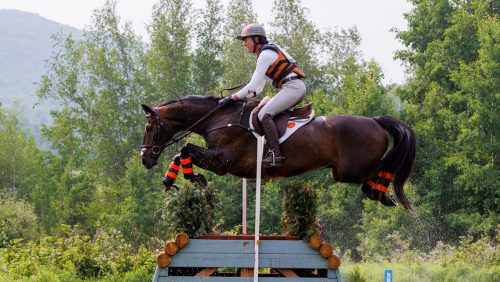After two deaths in the sport of eventing this fall in France—French rider Maxime Debost in a rotational fall at a one-star event and Boyd Martin’s mount Crackerjack due to a fractured limb while galloping on cross-country at the Pau CCI****—U.S. Eventing Association officials gathered a diverse group of industry players to discuss the state of safety in the sport with The Chronicle of the Horse.
This second article in the four-part series focuses on the USEA cardiovascular study and other studies being done to make the sport safer. This section of the conversation features USEA President Carol Kozlowski, USEA CEO Rob Burk and USEF Veterinary Committee Chair A. Kent Allen, DVM.
What’s the update on cardiopulmonary study being conducted by the USEA? Where does the funding for that study come from?
Rob Burk: One of the questions I ask people when they call me concerned about fatalities is: What do you think is the primary cause of fatality in eventing? I haven’t had anyone say to me yet “a cardiopulmonary event.” But from our numbers, the best we can say is that it’s cardiopulmonary related.
For several years a group from Ohio State and others private and public have been doing a number of things to look into cardiopulmonary research, and we’re constantly looking at ways to expand. We fund that in two primary ways. One, and most importantly, is donations to our USEA Foundation, but also for every horse trial in the United States, one dollar is set aside that goes into an equine health research pot. Those funds go toward the cardio-pulmonary research fund as well as other initiatives.
Dr. A. Kent Allen: Dr. Kohn, Catherine Kohn, who’s the chairman of that group, wrote a very nice summary that is on the USEA website, summarizing what’s gone on, and it has a link to further history.
ADVERTISEMENT
It’s been a long running study. The Americans were the first to start looking at this. There are now several European studies going on.
We know that when we run the horse at speed they’re at risk, from nothing more than that, for fractures and for cardiopulmonary issues. That’s speed. That’s something that comes with our sport. This is a very good look into the state of the event horse. I can tell you it’s going to be decades long looking at it, because it’s hard to find what you’re looking for because it doesn’t happen often. In human medicine it’s the same reason they can’t simply pull a blood test and say, “You’re going to have heart attack in two years. You need to do this.” It’s the same way with our horses.
Dr. A. Kent Allen, DVM, provides a cardiopulmonary case study involving Allison Springer and Arthur.
Burk: We know that about 1 in 27,000 starts results in a cardiopulmonary failure, and that’s actually dramatically improved over past five years, and that’s dramatically improved over the five years before that, which was 1 in 16,000. Hopefully the Allison and Arthur stories become more prevalent. [In April, Allison Springer retired her four-star veteran Arthur after a veterinary exam before the Rolex Kentucky CCI**** revealed a heart arrhythmia.]
The USEA will be working with Equiratings. Are you hoping that statistical analysis will help improve safety?
Burk: We’re hopeful. We’re implementing it this December. We’re going to do a rollout at the annual meeting of the USEA to explain how you’ll be able to find your [rating] online for any horse that’s registered with the USEA. When you register, you’ll be able to go online and check to see what its [rating] is.
So that will tell you, simply put, green, yellow, red, whether or not the horse is ready to go to a four-star all the way down to beginner novice. We’re hopeful the initial rollout will be helpful to inform if, whether or not, statistically speaking, their horse appears to be prepared at the level at which they want to compete it.
ADVERTISEMENT
At this point in time it’s for information in the United States. The only country that’s made it mandatory is Ireland, and we’re looking closely at how it’s going there. They have shown some initial strong results for one division, for the two-star division nationally.
Carol Kozlowski: I was really proud when we were able to make the connection with Equiratings because one of the criticisms we have of our sport is that we’re not statistically driven, that a lot of analysis is subjective and anecdotal. I love it when we can have math and data and statistics help us make really sound decisions. I think the partnership with Equiratings is a really good step in the right direction.
Burk: We already had some systems in place for several years like mandatory step-downs that require people, if they have two or three eliminations or falls, to have to step down and earn additional qualifications to get back up to that level. We’ll see how different Equiratings is from our pre-existing system. We’re excited.
Why aren’t approved vests required by the USEF?
Burk: I think it was last year or the year before we did put through a request for USEF to consider making [approved] vests mandatory. The issue we ran into, and why it was tabled, was certification and what standards to use. The certification standard is continually changing, so how do you set a rule that doesn’t limit you from being able to use the vest that you bought in November to use three months later in January of the following competition season? I’ll defer that to the USEF. That is something we have promoted making mandatory.
Don’t miss the next installment in this series, which focuses on eventing culture and rider responsibility and will be published tomorrow, Nov. 29.
Read the previous conversation here:
Part 1: Are We Going To Be Eventing Or Aren’t We?















